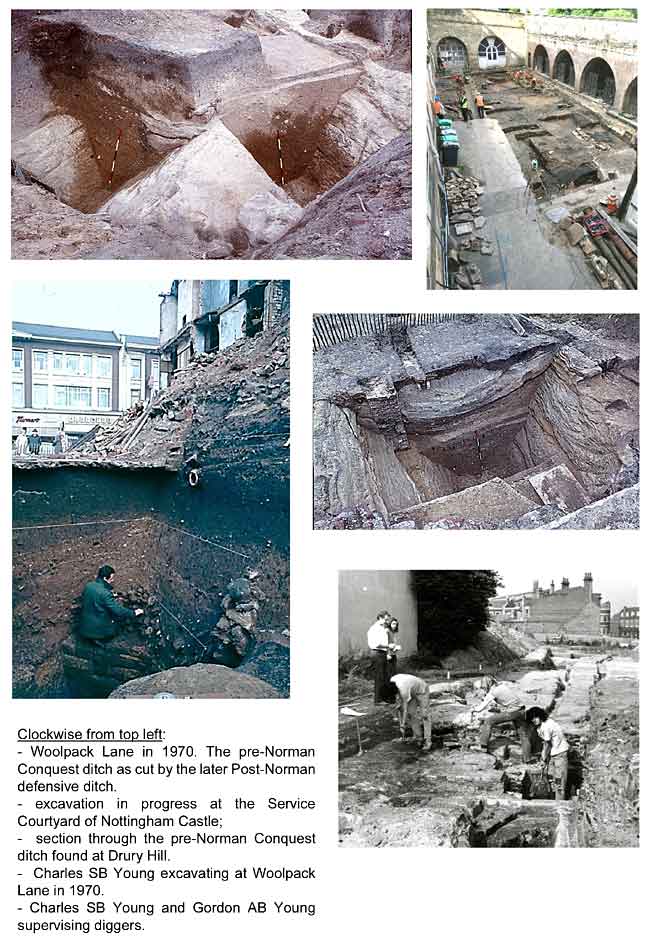Articles from the Thoroton Society Newsletter
Fifty years of professional archaeology in Nottingham
Scott Lomax
The year 2019 marks 50 years since Nottingham City Council first employed a professional archaeologist. Back in 1969, when Charles SB Young became Field Archaeologist working within the museum service, the City Council began to undertake a number of ‘rescue excavations’ in the city centre, as well as monitoring ground works, in order to record evidence of medieval and post-medieval occupation in advance of major redevelopment schemes.
It was in April 1969 that Professor Maurice Barley of the University of Nottingham recommended the city should employ a professional archaeologist. Barley recognised that major redevelopment works offered a unique opportunity for excavation and that through professional methods a detailed study of the evidence would reveal evidence of the character and chronology of settlement within the city’s historic core.
The development of the Broadmarsh Shopping Centre in particular demonstrated the need for a major programme of professional archaeological excavation. It was known, from study of the Anglo Saxon Chronicle and Assar’s The Life of Alfred that the great army of Danes had wintered in Nottingham in 868, with their camp having had defensive features of some form (variously described as ‘works’ and a ‘wall’). According to the Chronicle, Nottingham was held by the Danes between 877 and 918, with Nottingham forming one of the Five Boroughs of the Danelaw before being recaptured in 918. In that year, the Chronicle informs us, upon recapturing Nottingham Edward ordered the defences be strengthened.
Antiquarian observations, notably by Deering, who observed a ‘Saxon’ ditch being found during construction work on Drury Hill in the 1740s and Dobson who observed a ditch during the construction of a warehouse on Warser Gate in 1890, enabled the course of the ditch to be postulated. Further research by James Shipman by 1899 led to a projection of the full course of the ditch, around that part of the city we know as the Lace Market. A study of the topography and the distinctive street pattern of the Lace Market (or St Mary’s Hill as it was then known) was undertaken by WH Stevenson and published in Volume 16 of the Transactions. Stevenson hypothesised that streets such as Weekday Cross, Fletcher Gate, Warser Gate and Woolpack Lane followed the edge of the ditch, acting as intramural roads.
Excavations and observations by the Peverel Archaeological Group in the 1950s and early 1960s tested the earlier hypotheses, with partial, and occasional complete, sections of the ditch being encountered on a number of sites around the perimeter of the Lace Market. This formed the basis of a paper by RH Wildgoose in Volume 65 of the Transactions.
On the basis of knowledge acquired by 1969, the likelihood that the ditch would extend into the footprint of the new shopping centre was recognised, and it was realised that other significant remains of early medieval and later occupation could be found. The City Council, therefore, decided to establish the Nottingham City Museums Field Archaeology Section and appointed Charles SB Young as its director. Young’s first excavation, on the eastern side of Drury Hill, began in August 1969.
Under Young’s direction were a small number of professional site assistants as well as a number of volunteers, many of whom were school children (such as Julian Richards of Meet the Ancestors fame). Also assisting with the more physical tasks were a number of ‘Borstal Boys’ from Lowdham Grange and those employed under Manpower job creation schemes. The excavations and post-excavation work was largely funded by the Department for the Environment, with additional funding from the City Council as well as the Thoroton Society and a number of Nottingham companies, with later postexcavation analysis funded by English Heritage.
The Nottingham City Museums Field Archaeology Section continued this role, under Young’s direction, until the onset of developer-funded archaeology resulting from the introduction of the Planning Policy Guidance Note 16 (1990) and the growth of commercial field units. The final fieldwork undertaken by Young was at St Nicholas’ Church in 1991.
With its fieldwork role at an end, the ‘Field Section’ concentrated on writing up its backlog of excavations and the provision of advice to the city’s planning officers regarding development control archaeology and provided briefs to archaeological contractors to ensure work was completed to professional standards. At this time, the archaeological staff consisted of Young and his brother (and assistant) Gordon AB Young and Alan MacCormick, the Keeper of Human History.
In 1995 Gordon Young was appointed City Archaeologist whilst Charles continued to work on postexcavation analysis of his fieldwork, leaving the City Council in 1998. MacCormick continued his curatorial role until his retirement a few years later. The author first began working for Nottingham City Council in 2008, setting up the Urban Archaeological Database and later the Historic Environment Record, covering the role of City Archaeologist from 2016 onwards.
Although the role of City Archaeologist is very different from that undertaken by Charles Young, with more of a curatorial role, the City Council continues to ensure the preservation and appropriate investigation of archaeological remains so that the city’s past can be better understood and appreciated. It is apt that the 50th anniversary sees an unprecedented amount of archaeological work in the city, with 14 archaeological investigations in the first three months of 2019 alone.

< Previous